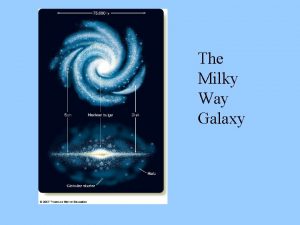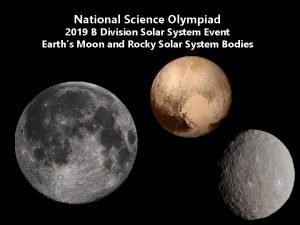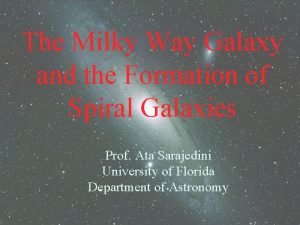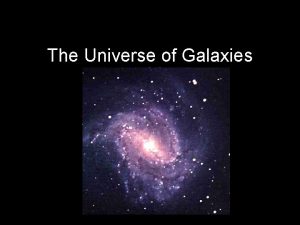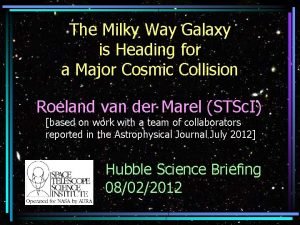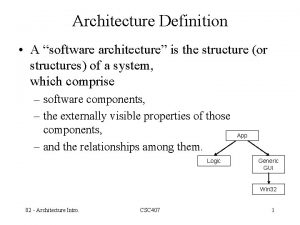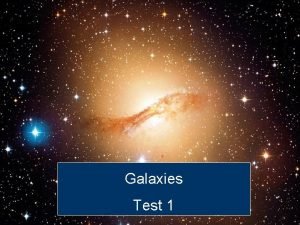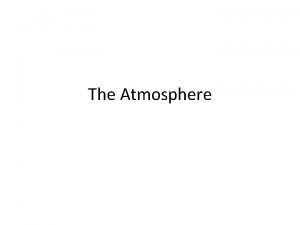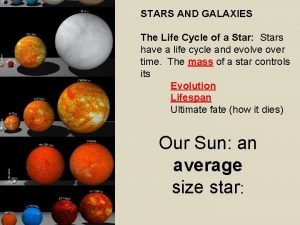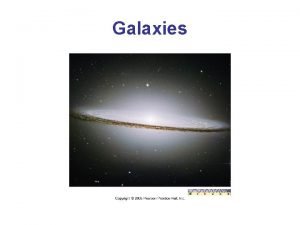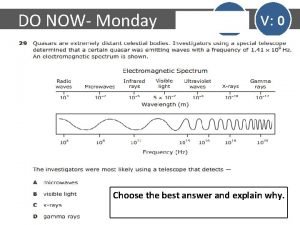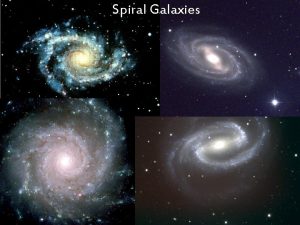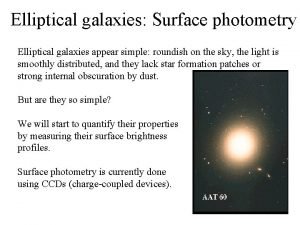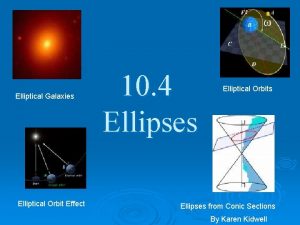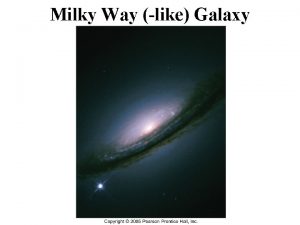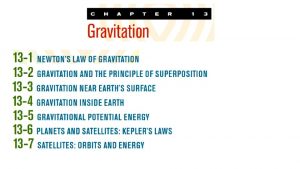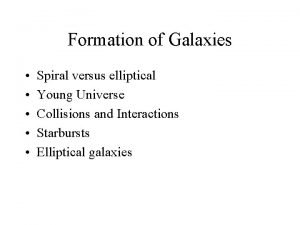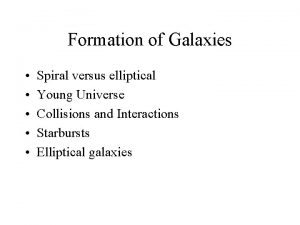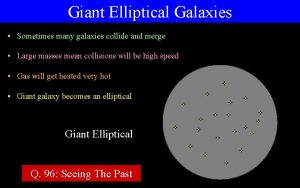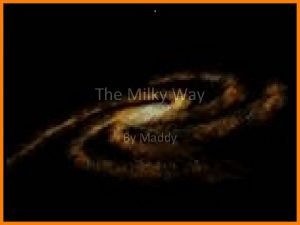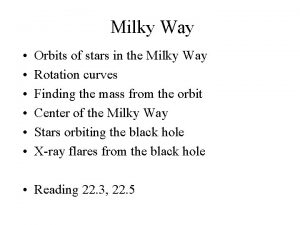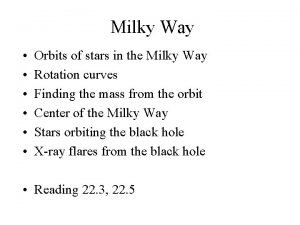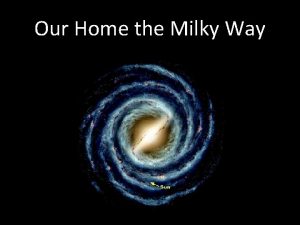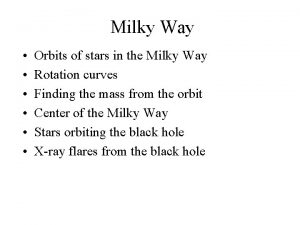Types of Galaxies Elliptical Spiral Irregular Milky Way




























- Slides: 28

Types of Galaxies Elliptical: Spiral: Irregular:

Milky Way Galaxy Supermassive Black Hole at center ~ 1 Million Solar Masses Sun - 2/3 of the way out on a spiral arm

Normal and Active Galaxies How do the luminosities of normal and active galaxies compare? What about their spectra? What resides at the center of most galaxies, including our own? Where is the Sun?

Active Galactic Nuclei (AGN) Several hundreds of trillions of solar luminosities! Spectrum is not black body => luminosity not due to starlight alone! What is the power source?

Evolution of Galaxies: Caused by merging and interactions between Galaxies.

AGN Energy Source Rapidly varying intensity => small size High luminosity and small size => supermassive black hole Billions of solar masses! Consumes entire stars!

Cosmic Distance Scale “Standard Candles” Extremely bright events with well-known luminosities Ex. Type Ia (carbondetonation) supernovae Works out to ~ 3 billion light years! Recall: Apparent Brightness = Luminosity/Distance^2

Structures of Galaxies On intermediate scales, galaxies form identifiable structures. Groups Clusters Superclusters The “Local” Supercluster

Cosmological Structure? How is matter distributed in the universe on the very largest scales?

No Structure on Largest Scales (Galaxies distributed fairly uniformly) Surprising given observations of groups, clusters, and superclusters on smaller scales Cosmological Principle: Universe is homogeneous and isotropic Homogeneity => ?

Olbers` Paradox If universe is homogeneous, isotropic, infinite in extent, and unchanging, then any line of sight from Earth should eventually run into a star. What observable effect would this have on the night sky? Why isn't this what we see?

The universe is expanding => Assumption that universe is unchanging is incorrect => Doesn’t matter whether universe is finite or infinite, we only see a finite part => Light from objects greater than 14 billion light years away has not had time to reach us!

Hubble Expansion Analogy 1 Mpc 6 Mpc 12 Mpc 1 pc ~ 3 Light Years 2 Mpc 12 Mpc 24 Mpc Accuracy increases with distance. The farther out , the faster the expansion. Works for any chosen point of reference. Hubble's Law: v = H 0 x distance

The Fate of the Universe What property determines the ultimate fate of the universe? What does the best available data tell us about how the expansion rate of the universe is changing?

Affect of Density on the Universe As best we can tell, the expansion rate of the universe is increasing!

Question What is it that is causing the expansion of the universe to accelerate? What is the biggest single contributor to the overall density of the universe? DARK ENERGY

The Big Bang Primordial explosion thought to be the creation of our universe – all matter and space, “beginning” of time. Hot and dense conditions => early universe was opaque to radiation! Primordial nucleosynthesis Source of Cosmic Microwave Background Radiation

Evidence for the Big Bang Primordial Nucleosynthesis Creation of base level of helium (~25%) in the early universe Stopped because temperature and density became too low (due to expansion) for fusion to continue Also, Hubble's Law and CMBR

The Horizon Problem CMBR - Leftover radiation from the Big Bang How is the CMBR distributed across the sky? Why is this a problem?

The Flatness Problem The cosmic density appears to be fairly close to the critical value No obvious reason why universe should have exactly the critical density! What theory solves both the horizon and flatness problems?

The Theory of Inflation The universe swelled in size by a factor of about 1050 in only 10 -32 seconds! Solves both horizon and flatness problems! How?

Extraterrestrial Life (as We Know It) “Life as we know it” is generally taken to mean carbonbased life that originated in a liquid-water environment. Requirements? Liquid water, protection from radiation, temperate climate What are some important characteristics of living organisms?

Characteristics of a Living Organism Responsiveness to environment Reproduction/replication Capacity to evolve Ability to take in nourishment, grow, and heal

The Miller-Urey experiment attempts to recreate the chemical conditions of the primitive Earth in the laboratory, and synthesize some of the building blocks of life. Supports the assumptions of mediocrity!

The Drake Equation What is the Drake equation designed to estimate? Which terms have astronomers measured most accurately?

The Drake Equation number of technological, intelligent civilizations in the Milky Way x fraction of those habitable planets on which life arises rate at which new stars are formed (avg. over galactic lifetime) = x fraction of those life-bearing planets on which intelligence evolves x x fraction of stars having planetary systems fraction of those planets with intelligent life that develop technological society x x average number of habitable planets within those planetary systems average lifetime of a technological civilization Each term is less certain than the preceding one! Only in last ten years have we addressed the second term.

SETI Search for Extra. Terrestrial Intelligence - Listens for radio signals from alien worlds Microwave Window - in radio part of EM spectrum - Minimal noise - Referred to as the “Water Hole”

Good luck and have a great summer!
 Galaxie s
Galaxie s Elliptical galaxies facts
Elliptical galaxies facts Type of galaxy
Type of galaxy Milky way description
Milky way description Where is the solar system located in the milky way
Where is the solar system located in the milky way Democritus milky way
Democritus milky way Science olympiad solar system
Science olympiad solar system Canis major dwarf galaxy
Canis major dwarf galaxy Dung beetle milky way
Dung beetle milky way Our location in the milky way
Our location in the milky way The milky way
The milky way Milky way galaxy sketch
Milky way galaxy sketch Fonterra milkyway
Fonterra milkyway Critical density
Critical density Lengkung spiral
Lengkung spiral What does architecture mean in software
What does architecture mean in software 4 types of galaxies
4 types of galaxies Types of galaxies
Types of galaxies Glowing splint
Glowing splint Zjezd
Zjezd Nemertea diagram
Nemertea diagram Milky appearance of plasma
Milky appearance of plasma Waves are produced by stars and galaxies
Waves are produced by stars and galaxies Life cycle of galaxies
Life cycle of galaxies E irregulars
E irregulars The pity relation for an adiabatic expansion is
The pity relation for an adiabatic expansion is Chapter 30 galaxies and the universe
Chapter 30 galaxies and the universe Brainpop galaxies quiz answers
Brainpop galaxies quiz answers How are galaxies classified? *
How are galaxies classified? *



